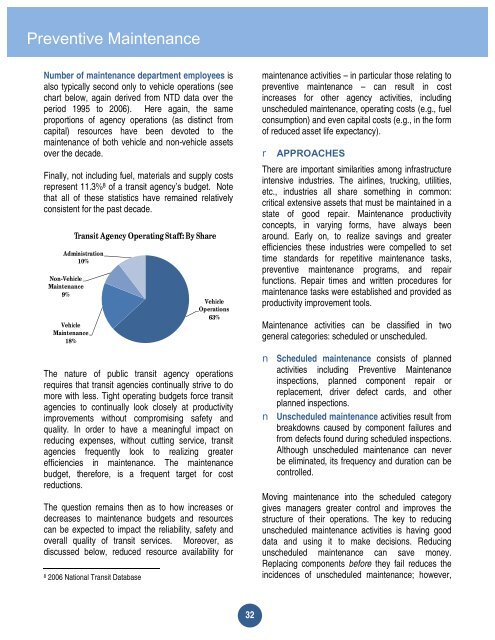Beginning the Dialogue - Report on SGR - Federal Transit ...
Beginning the Dialogue - Report on SGR - Federal Transit ...
Beginning the Dialogue - Report on SGR - Federal Transit ...
You also want an ePaper? Increase the reach of your titles
YUMPU automatically turns print PDFs into web optimized ePapers that Google loves.
Preventive Maintenance<br />
Number of maintenance department employees is<br />
also typically sec<strong>on</strong>d <strong>on</strong>ly to vehicle operati<strong>on</strong>s (see<br />
chart below, again derived from NTD data over <str<strong>on</strong>g>the</str<strong>on</strong>g><br />
period 1995 to 2006). Here again, <str<strong>on</strong>g>the</str<strong>on</strong>g> same<br />
proporti<strong>on</strong>s of agency operati<strong>on</strong>s (as distinct from<br />
capital) resources have been devoted to <str<strong>on</strong>g>the</str<strong>on</strong>g><br />
maintenance of both vehicle and n<strong>on</strong>-vehicle assets<br />
over <str<strong>on</strong>g>the</str<strong>on</strong>g> decade.<br />
Finally, not including fuel, materials and supply costs<br />
represent 11.3% 8 of a transit agency’s budget. Note<br />
that all of <str<strong>on</strong>g>the</str<strong>on</strong>g>se statistics have remained relatively<br />
c<strong>on</strong>sistent for <str<strong>on</strong>g>the</str<strong>on</strong>g> past decade.<br />
<strong>Transit</strong> Agency Operating Staff: By Share<br />
Administrati<strong>on</strong><br />
10%<br />
N<strong>on</strong>-Vehicle<br />
Maintenance<br />
9%<br />
Vehicle<br />
Maintenance<br />
18%<br />
Vehicle<br />
Operati<strong>on</strong>s<br />
63%<br />
The nature of public transit agency operati<strong>on</strong>s<br />
requires that transit agencies c<strong>on</strong>tinually strive to do<br />
more with less. Tight operating budgets force transit<br />
agencies to c<strong>on</strong>tinually look closely at productivity<br />
improvements without compromising safety and<br />
quality. In order to have a meaningful impact <strong>on</strong><br />
reducing expenses, without cutting service, transit<br />
agencies frequently look to realizing greater<br />
efficiencies in maintenance. The maintenance<br />
budget, <str<strong>on</strong>g>the</str<strong>on</strong>g>refore, is a frequent target for cost<br />
reducti<strong>on</strong>s.<br />
The questi<strong>on</strong> remains <str<strong>on</strong>g>the</str<strong>on</strong>g>n as to how increases or<br />
decreases to maintenance budgets and resources<br />
can be expected to impact <str<strong>on</strong>g>the</str<strong>on</strong>g> reliability, safety and<br />
overall quality of transit services. Moreover, as<br />
discussed below, reduced resource availability for<br />
8 2006 Nati<strong>on</strong>al <strong>Transit</strong> Database<br />
32<br />
maintenance activities – in particular those relating to<br />
preventive maintenance – can result in cost<br />
increases for o<str<strong>on</strong>g>the</str<strong>on</strong>g>r agency activities, including<br />
unscheduled maintenance, operating costs (e.g., fuel<br />
c<strong>on</strong>sumpti<strong>on</strong>) and even capital costs (e.g., in <str<strong>on</strong>g>the</str<strong>on</strong>g> form<br />
of reduced asset life expectancy).<br />
r APPROACHES<br />
There are important similarities am<strong>on</strong>g infrastructure<br />
intensive industries. The airlines, trucking, utilities,<br />
etc., industries all share something in comm<strong>on</strong>:<br />
critical extensive assets that must be maintained in a<br />
state of good repair. Maintenance productivity<br />
c<strong>on</strong>cepts, in varying forms, have always been<br />
around. Early <strong>on</strong>, to realize savings and greater<br />
efficiencies <str<strong>on</strong>g>the</str<strong>on</strong>g>se industries were compelled to set<br />
time standards for repetitive maintenance tasks,<br />
preventive maintenance programs, and repair<br />
functi<strong>on</strong>s. Repair times and written procedures for<br />
maintenance tasks were established and provided as<br />
productivity improvement tools.<br />
Maintenance activities can be classified in two<br />
general categories: scheduled or unscheduled.<br />
n Scheduled maintenance c<strong>on</strong>sists of planned<br />
activities including Preventive Maintenance<br />
inspecti<strong>on</strong>s, planned comp<strong>on</strong>ent repair or<br />
replacement, driver defect cards, and o<str<strong>on</strong>g>the</str<strong>on</strong>g>r<br />
planned inspecti<strong>on</strong>s.<br />
n Unscheduled maintenance activities result from<br />
breakdowns caused by comp<strong>on</strong>ent failures and<br />
from defects found during scheduled inspecti<strong>on</strong>s.<br />
Although unscheduled maintenance can never<br />
be eliminated, its frequency and durati<strong>on</strong> can be<br />
c<strong>on</strong>trolled.<br />
Moving maintenance into <str<strong>on</strong>g>the</str<strong>on</strong>g> scheduled category<br />
gives managers greater c<strong>on</strong>trol and improves <str<strong>on</strong>g>the</str<strong>on</strong>g><br />
structure of <str<strong>on</strong>g>the</str<strong>on</strong>g>ir operati<strong>on</strong>s. The key to reducing<br />
unscheduled maintenance activities is having good<br />
data and using it to make decisi<strong>on</strong>s. Reducing<br />
unscheduled maintenance can save m<strong>on</strong>ey.<br />
Replacing comp<strong>on</strong>ents before <str<strong>on</strong>g>the</str<strong>on</strong>g>y fail reduces <str<strong>on</strong>g>the</str<strong>on</strong>g><br />
incidences of unscheduled maintenance; however,

















